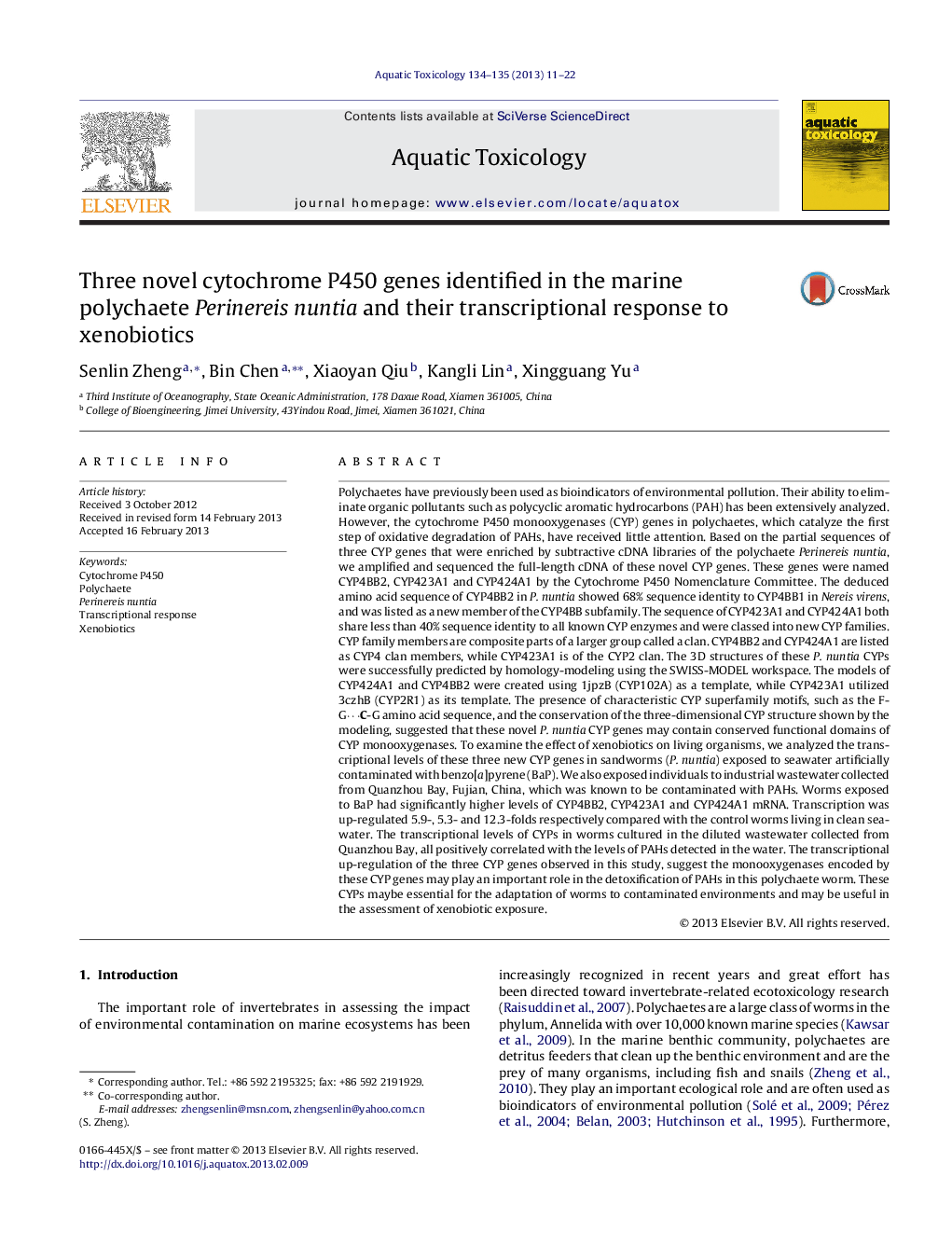| کد مقاله | کد نشریه | سال انتشار | مقاله انگلیسی | نسخه تمام متن |
|---|---|---|---|---|
| 4529508 | 1625965 | 2013 | 12 صفحه PDF | دانلود رایگان |

Polychaetes have previously been used as bioindicators of environmental pollution. Their ability to eliminate organic pollutants such as polycyclic aromatic hydrocarbons (PAH) has been extensively analyzed. However, the cytochrome P450 monooxygenases (CYP) genes in polychaetes, which catalyze the first step of oxidative degradation of PAHs, have received little attention. Based on the partial sequences of three CYP genes that were enriched by subtractive cDNA libraries of the polychaete Perinereis nuntia, we amplified and sequenced the full-length cDNA of these novel CYP genes. These genes were named CYP4BB2, CYP423A1 and CYP424A1 by the Cytochrome P450 Nomenclature Committee. The deduced amino acid sequence of CYP4BB2 in P. nuntia showed 68% sequence identity to CYP4BB1 in Nereis virens, and was listed as a new member of the CYP4BB subfamily. The sequence of CYP423A1 and CYP424A1 both share less than 40% sequence identity to all known CYP enzymes and were classed into new CYP families. CYP family members are composite parts of a larger group called a clan. CYP4BB2 and CYP424A1 are listed as CYP4 clan members, while CYP423A1 is of the CYP2 clan. The 3D structures of these P. nuntia CYPs were successfully predicted by homology-modeling using the SWISS-MODEL workspace. The models of CYP424A1 and CYP4BB2 were created using 1jpzB (CYP102A) as a template, while CYP423A1 utilized 3czhB (CYP2R1) as its template. The presence of characteristic CYP superfamily motifs, such as the F-G⋯C-G amino acid sequence, and the conservation of the three-dimensional CYP structure shown by the modeling, suggested that these novel P. nuntia CYP genes may contain conserved functional domains of CYP monooxygenases. To examine the effect of xenobiotics on living organisms, we analyzed the transcriptional levels of these three new CYP genes in sandworms (P. nuntia) exposed to seawater artificially contaminated with benzo[a]pyrene (BaP). We also exposed individuals to industrial wastewater collected from Quanzhou Bay, Fujian, China, which was known to be contaminated with PAHs. Worms exposed to BaP had significantly higher levels of CYP4BB2, CYP423A1 and CYP424A1 mRNA. Transcription was up-regulated 5.9-, 5.3- and 12.3-folds respectively compared with the control worms living in clean seawater. The transcriptional levels of CYPs in worms cultured in the diluted wastewater collected from Quanzhou Bay, all positively correlated with the levels of PAHs detected in the water. The transcriptional up-regulation of the three CYP genes observed in this study, suggest the monooxygenases encoded by these CYP genes may play an important role in the detoxification of PAHs in this polychaete worm. These CYPs maybe essential for the adaptation of worms to contaminated environments and may be useful in the assessment of xenobiotic exposure.
► Novel genes, CYP4BB2, CYP423A1 and CYP424A1 were indentified in Perinereis nuntia.
► Motifs analysis and structure modeling suggests they have conserved CYP characteristics.
► Alignment and phylogenic analysis suggests they are not quite similar with known CYPs.
► CYP4BB2 and CYP424A1 are classed into CYP4 clan, while CYP423A1 into CYP2 clan.
► These CYPs are inducible by BaP and may be useful markers for marine pollution.
Journal: Aquatic Toxicology - Volumes 134–135, 15 June 2013, Pages 11–22